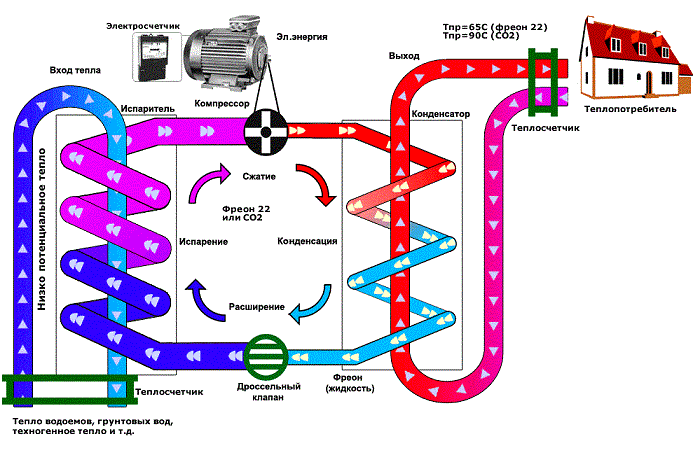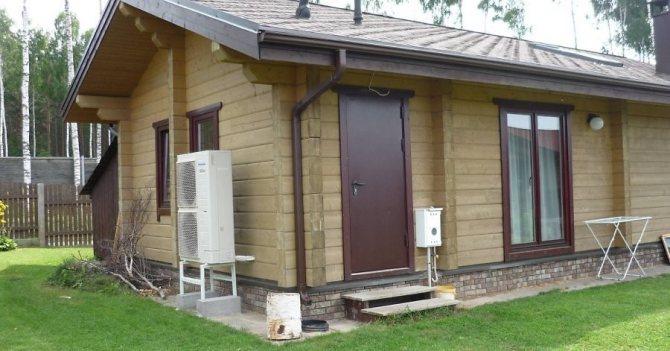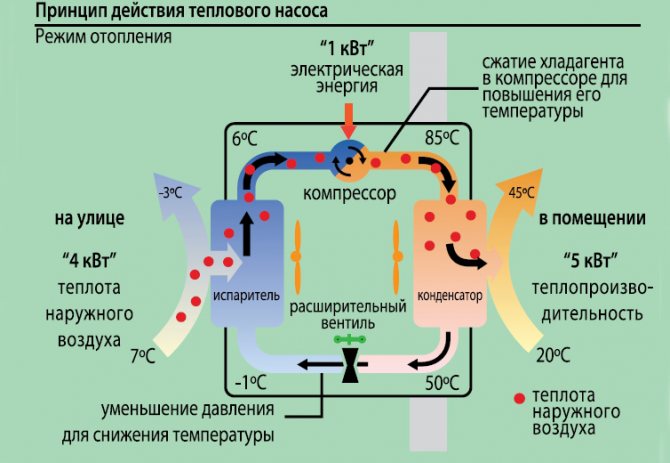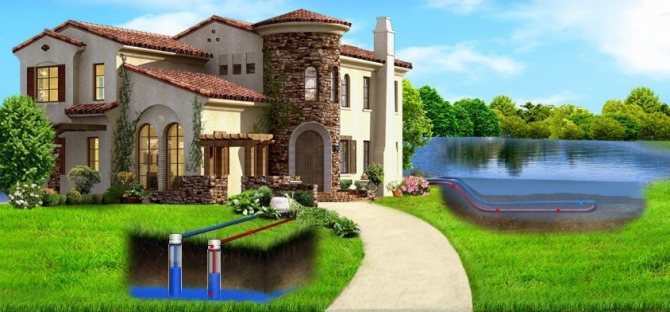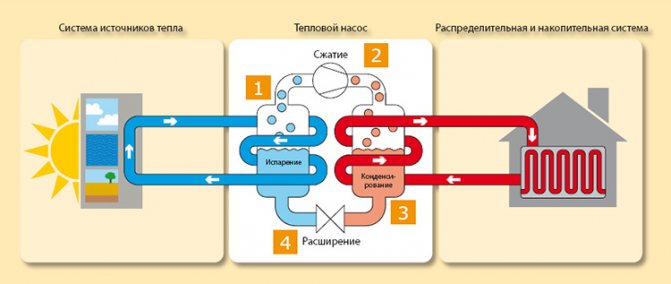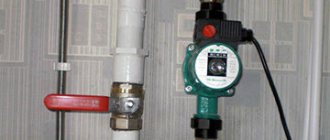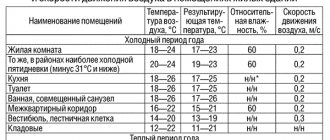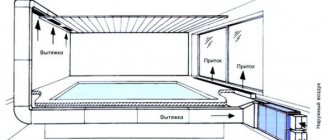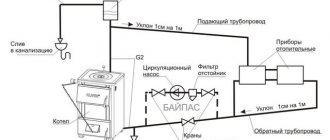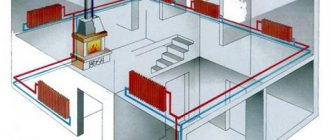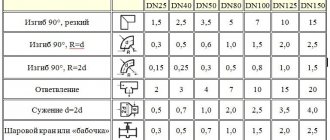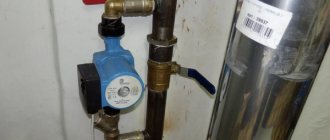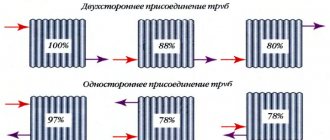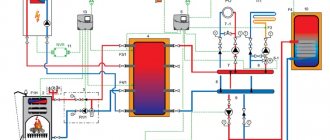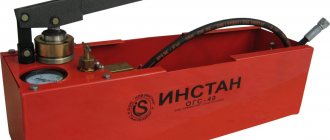Types of heat pump designs
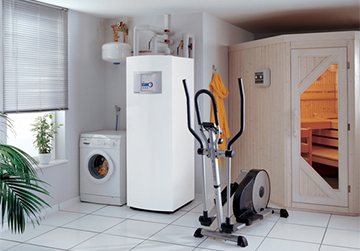
The type of heat pump is usually denoted by a phrase indicating the source medium and heat carrier of the heating system.
There are the following varieties:
- ТН "air - air";
- ТН "air - water";
- TN "soil - water";
- TH "water - water".
The very first option is a conventional split system operating in heating mode. The evaporator is mounted outdoors, and a unit with a condenser is installed inside the house. The latter is blown by a fan, due to which a warm air mass is supplied to the room.
If such a system is equipped with a special heat exchanger with nozzles, the HP type "air-water" will be obtained. It is connected to a water heating system.
The HP evaporator of the "air-to-air" or "air-to-water" type can be placed not outdoors, but in the exhaust ventilation duct (it must be forced). In this case, the efficiency of the heat pump will be increased several times.
Heat pumps of the "water-to-water" and "soil-to-water" type use a so-called external heat exchanger or, as it is also called, a collector to extract heat.
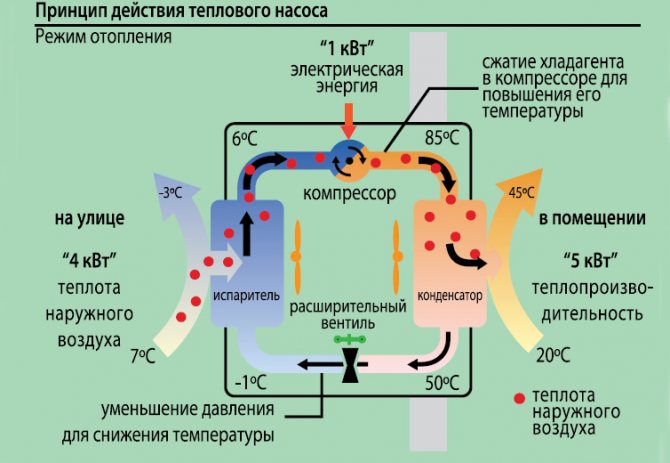

Schematic diagram of the heat pump
This is a long looped tube, usually plastic, through which a liquid medium circulates around the evaporator. Both types of heat pumps represent the same device: in one case, the collector is immersed at the bottom of a surface reservoir, and in the second - into the ground. The condenser of such a heat pump is located in a heat exchanger connected to the hot water heating system.
Connection of heat pumps according to the "water - water" scheme is much less laborious than "soil - water", since there is no need to carry out earthworks. At the bottom of the reservoir, the pipe is laid in the form of a spiral. Of course, for this scheme, only a reservoir is suitable that does not freeze to the bottom in winter.
Classification of heat pumps according to the characteristics of the media
The classification of heat pumps is quite voluminous. Devices are divided according to the type of the working fluid, the principle of changing its physical state, the use of conversion devices, the nature of the energy carrier necessary for the operation. Considering that there are models on the market with various combinations of classification criteria, it becomes clear that it is quite difficult to list everything. However, you can consider the basic principles of group division.
The installation, design and final characteristics of the heat pump depend on the parameters of the heat source and the recipient medium. Several types of engineering solutions are offered today.
Air-to-air
Air-to-air heat pumps are the most common devices. They are compact and simple enough. Household air conditioners with heating mode operate on mechanics of this type. The principle of operation is simple:
- an outdoor heat exchanger is cooled below the air temperature and removes heat;
- after the compression of the incoming freon into the radiator, its temperature increases greatly;
- the fan inside the room, blowing on the heat exchanger, heats the room.
The extraction of energy from the environment is not necessarily carried out by an external heat exchanger. For this purpose, air can be blown into a unit located in the room. This is how some channel systems work.
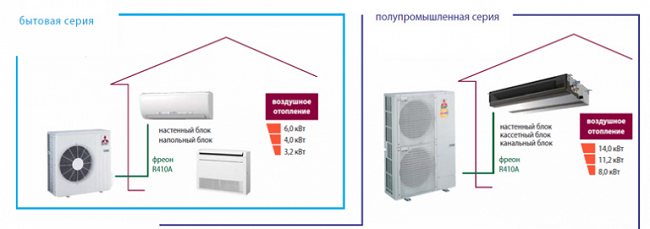

If freon is compressed and expanded in an air conditioner, then simple air is used in vortex heat pumps. The mechanics of work are similar: before entering the internal heat exchanger, the gas is compressed, and having given off energy, it is blown into the heat extraction chamber by an intense flow.
A vortex heat pump is a large, massive installation that only works efficiently when the ambient temperature is high. Therefore, such systems are installed in industrial workshops, they use the exhaust gases of the furnaces or the hot air of the main air conditioning system as a heat source.
Water-water
A water-to-water heat pump works on the same principle as other installations. Only the transmission media are different. The equipment is equipped with submersible probes in order to get to the groundwater horizon with a positive temperature even in a harsh winter.
Depending on the heating needs, water-to-water heat pump systems can be of completely different sizes. For example, starting from several wells drilled around a private house, ending with large area heat exchangers located directly in the aquifer, which are laid during the construction phase of the building.
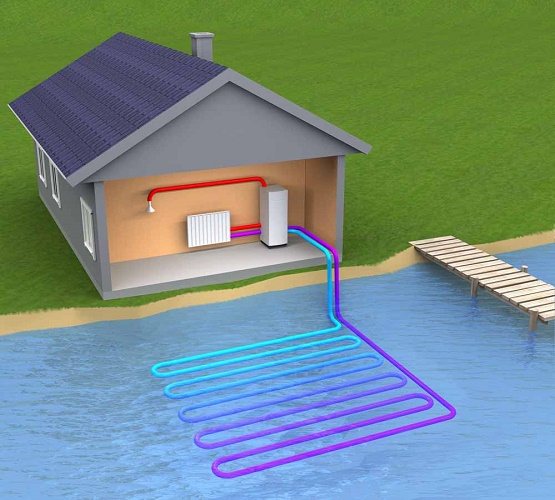

Water-to-water heat pumps are distinguished by higher productivity and effective output power... The reason is the increased heat capacity of the liquid. The water layer in which the probe or heat exchanger is located quickly releases energy, and due to its huge volume, it slightly reduces its characteristics, contributing to the stable operation of the system. Also, water-water equipment is characterized by increased efficiency.
Advice! Under certain conditions, the water-water circuit can do without intermediate nodes in the form of storage tanks for the heating network. Correctly assessing the existing climatic conditions and choosing the power of the installation, a water heater with a heat pump is installed in the house and an effective floor heating system is organized.
Water-air, air-water
Combined systems must be chosen with particular care. At the same time, the existing climatic conditions are carefully assessed. For example, a water-to-air heat pump cycle has good heating efficiency in regions with severe frost. The air-water system in conjunction with a warm floor and a storage boiler for secondary heating is able to show the maximum savings in areas where the air temperature rarely drops below -5 ... -10 degrees.
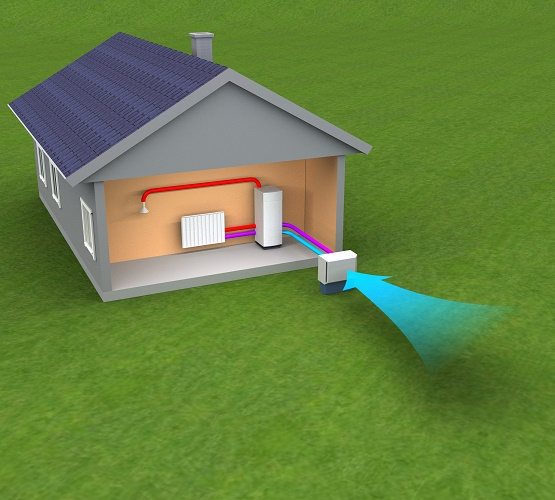

Melt (brine) -water
A heat pump of this class is a kind of universal. It can be used literally everywhere. Indicators of its useful heat output are constant and stable. The principle of operation of the brine-water device is based on the extraction of heat, first of all, from the soil, which has normal moisture values or is waterlogged.
The system is easy to install: to place external heat exchangers, it is enough to bury them to a certain depth. You can also choose one of the options for equipment with a gaseous or liquid working fluid.
The calculation of a heat pump of the brine-water class is based on the level of energy demand for heating. There are plenty of methods for its quantitative determination. You can make the most accurate calculation, taking into account the material of the walls of the house, the construction of the windows, the nature of the soil, the weighted average air temperature and much more.
Manufacturers of brine-water systems offer various options for models that differ in the power consumption of the conversion unit, the design and dimensions of external heat exchangers, and the parameters of the output circuit. It is not difficult to choose the optimal heat pump according to a pre-formed list of requirements.
It's time to substantively study foreign experience
Almost everyone now knows about heat pumps capable of extracting heat from the environment for heating buildings, and if not long ago a potential customer usually asked the bewildered question “how is this possible?”, Now the question “how is it correct? to do? "
The answer to this question is not easy.
In search of answers to the numerous questions that inevitably arise when trying to design heating systems with heat pumps, it is advisable to turn to the experience of specialists in those countries where heat pumps on ground heat exchangers have been used for a long time.
A visit * to the American exhibition AHR EXPO-2008, which was undertaken mainly in order to obtain information on the methods of engineering calculations of ground heat exchangers, did not bring direct results in this direction, but a book was sold at the ASHRAE exhibition stand, some provisions of which served as the basis for this publications.
It should be said right away that the transfer of the American methodology to domestic soil is not an easy task. For Americans, things are not the same as in Europe. Only they measure time in the same units as we do. All other units of measurement are purely American, or rather British. The Americans were especially unlucky with heat flux, which can be measured both in British thermal units per unit of time, and in tons of refrigeration, which were probably invented in America.
The main problem, however, was not the technical inconvenience of recalculating the units of measurement adopted in the United States, to which one can get used to it over time, but the absence in the mentioned book of a clear methodological basis for constructing a calculation algorithm. Too much space is given to routine and well-known calculation methods, while some important provisions remain completely undisclosed.
In particular, such physically related initial data for calculating vertical ground heat exchangers, such as the temperature of the fluid circulating in the heat exchanger and the conversion factor of the heat pump, cannot be set arbitrarily, and before proceeding with calculations related to unsteady heat transfer in the ground, it is necessary to determine the relationships connecting these parameters.
The criterion for the efficiency of a heat pump is the conversion coefficient α, the value of which is determined by the ratio of its thermal power to the power of the compressor electric drive. This value is a function of the boiling points tu in the evaporator and tk of condensation, and in relation to water-to-water heat pumps, we can talk about the liquid temperatures at the outlet from the evaporator t2I and at the outlet from the condenser t2K:
? =? (t2И, t2K). (one)
Analysis of the catalog characteristics of serial refrigerating machines and water-to-water heat pumps made it possible to display this function in the form of a diagram (Fig. 1).
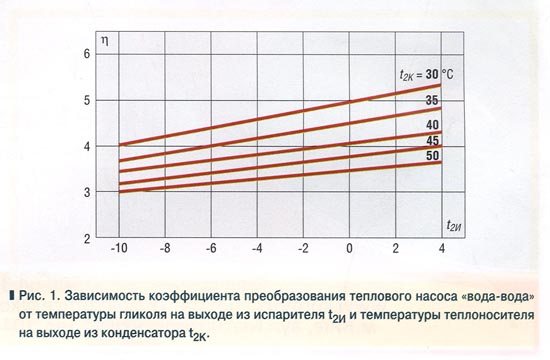

Using the diagram, it is easy to determine the parameters of the heat pump at the very initial stages of design. It is obvious, for example, that if the heating system connected to the heat pump is designed to supply a heating medium with a flow temperature of 50 ° C, then the maximum possible conversion factor of the heat pump will be about 3.5. At the same time, the temperature of the glycol at the outlet of the evaporator should not be lower than + 3 ° С, which means that an expensive ground heat exchanger will be required.
At the same time, if the house is heated by means of a warm floor, a heat carrier with a temperature of 35 ° C will enter the heating system from the condenser of the heat pump. In this case, the heat pump will be able to work more efficiently, for example, with a conversion factor of 4.3, if the temperature of the glycol cooled in the evaporator is about –2 ° C.
Using Excel spreadsheets, you can express function (1) as an equation:
? = 0.1729 • (41.5 + t2I - 0.015t2I • t2K - 0.437 • t2K (2)
If, at the desired conversion factor and a given value of the temperature of the coolant in the heating system powered by a heat pump, it is necessary to determine the temperature of the liquid cooled in the evaporator, then equation (2) can be represented as:
(3)
You can choose the temperature of the coolant in the heating system at the given values of the conversion coefficient of the heat pump and the temperature of the liquid at the outlet from the evaporator using the formula:
(4)
In formulas (2) ... (4) temperatures are expressed in degrees Celsius.
Having identified these dependencies, we can now go directly to the American experience.
Method for calculating heat pumps
Of course, the process of selecting and calculating a heat pump is a technically very complicated operation and depends on the individual characteristics of the object, but it can be roughly reduced to the following stages:
Heat losses through the building envelope (walls, ceilings, windows, doors) are determined. This can be done by applying the following ratio:
Qok = S * (tvn - tnar) * (1 + Σ β) * n / Rt (W) where
tnar - outside air temperature (° С);
tvn - internal air temperature (° С);
S is the total area of all enclosing structures (m2);
n - coefficient indicating the influence of the environment on the characteristics of the object. For rooms in direct contact with the outside environment through the ceilings n = 1; for objects with attic floors n = 0.9; if the object is located above the basement n = 0.75;
β is the coefficient of additional heat loss, which depends on the type of structure and its geographical location β can vary from 0.05 to 0.27;
RT - thermal resistance, is determined by the following expression:
Rt = 1 / αint + Σ (δі / λі) + 1 / αout (m2 * ° С / W), where:
δі / λі is a calculated indicator of thermal conductivity of materials used in construction.
αout is the coefficient of thermal dissipation of the outer surfaces of the enclosing structures (W / m2 * оС);
αin - the coefficient of thermal absorption of the internal surfaces of the enclosing structures (W / m2 * оС);
- The total heat loss of the structure is calculated by the formula:
Qt.pot = Qok + Qi - Qbp, where:
Qi - energy consumption for heating the air entering the room through natural leaks;
Qbp - heat release due to the functioning of household appliances and human activities.
2. Based on the data obtained, the annual consumption of heat energy for each individual object is calculated:
Qyear = 24 * 0.63 * Qt. pot. * ((d * (tvn - tout.) / (tvn - tout.)) (kW / hour per year.) where:
tвн - recommended indoor air temperature;
tnar - outside air temperature;
tout.av - the arithmetic mean value of the outside air temperature for the entire heating season;
d is the number of days of the heating period.
3. For a complete analysis, you will also need to calculate the level of thermal power required to heat the water:
Qgv = V * 17 (kW / hour per year.) Where:
V is the volume of daily heating of water up to 50 ° С.
Then the total consumption of heat energy will be determined by the formula:
Q = Qgv + Qyear (kW / hour per year.)
Taking into account the obtained data, it will not be difficult to choose the most suitable heat pump for heating and hot water supply. Moreover, the calculated power will be determined as. Qtn = 1.1 * Q, where:
Qtn = 1.1 * Q, where:
1.1 is a correction factor indicating the possibility of increasing the load on the heat pump during the period of critical temperatures.
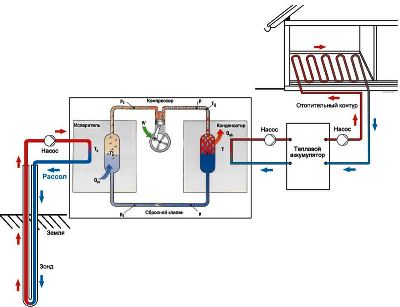

After calculating heat pumps, you can select the most suitable heat pump capable of providing the required microclimate parameters in rooms with any technical characteristics. And given the possibility of integrating this system with a climate control unit, a warm floor can be noted not only for its functionality, but also for its high aesthetic cost.
How to make a DIY heat pump?
The cost of a heat pump is quite high, even if you do not take into account the payment for the services of a specialist who will install it. Not everyone has sufficient financial capacityto immediately pay for the installation of such equipment. In this regard, many are beginning to ask the question, is it possible to make a heat pump with your own hands from scrap materials? That's quite possible. In addition, during work, you can use not new, but used spare parts.
So, if you decide to create a heat pump with your own hands, then before starting work, you must:
- check the condition of the wiring in your home;
- make sure that the electricity meter is working and check that the power of this device is at least 40 amperes.
The first step is to buy a compressor... You can buy it in specialized companies or by contacting a refrigeration equipment repair shop. There you can purchase a compressor from an air conditioner. It is quite suitable for creating a heat pump. Next, it must be fixed to the wall using the L-300 brackets.
Now you can proceed to the next stage - the manufacture of the capacitor. To do this, you need to find a stainless steel tank for water with a volume of up to 120 liters. It is cut in half, and a coil is installed inside it. You can make it yourself using a copper tube from the refrigerator. Alternatively, you can create it from a small diameter copper pipe.
In order not to experience problems with the manufacture of the coil, it is necessary to take a regular gas cylinder and wind copper wire around it... During this work, it is necessary to pay attention to the distance between the turns, which should be the same. To fix the tube in this position, you should use an aluminum perforated corner, which is used to protect the corners of the putty. Using coils, the tubes should be positioned so that the coils of the wire are opposite the holes in the corner. This will ensure the same pitch of turns, and besides this, the structure will be quite strong.
When the coil is installed, the two halves of the prepared tank are connected by welding. In this case, care must be taken to weld threaded connections.
To create the evaporator, you can use plastic water containers with a total volume of 60 - 80 liters. The coil is mounted in it from a pipe with a diameter of ¾ ". Ordinary water pipes can be used to deliver and drain water.
On the wall using the L-bracket of the desired size fixing the evaporator.
When all the work is completed, all that remains is to invite a refrigeration specialist. He will assemble the system, weld the copper pipes and pump in freon.
Heat pump types
Heat pumps are divided into three main types according to the source of low-grade energy:
- Air.
- Priming.
- Water - The source can be groundwater and surface water bodies.
For water heating systems, which are more common, the following types of heat pumps are used:
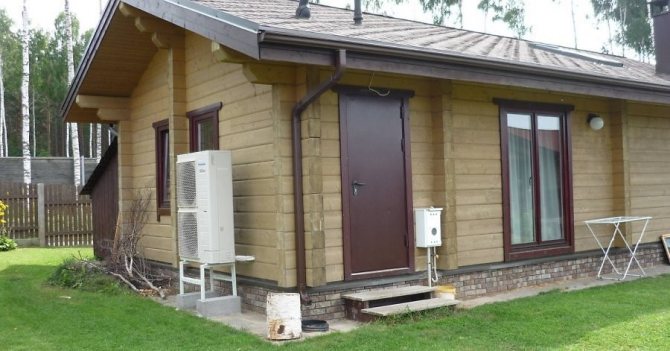

Air-to-water is an air type heat pump that heats a building by drawing in air from the outside through an external unit. It works on the principle of an air conditioner, only the other way around, converting air energy into heat. Such a heat pump does not require large installation costs, it is not necessary to allocate a plot of land for it and, moreover, to drill a well. However, the efficiency of operation at low temperatures (-25 ° C) decreases and an additional source of thermal energy is required.
The device "ground-water" refers to geothermal and produces heat from the ground using a collector laid at a depth below the freezing of the ground. Also, there is a dependence on the area of the site and the landscape, if the collector is located horizontally. For a vertical position, you will need to drill a well.
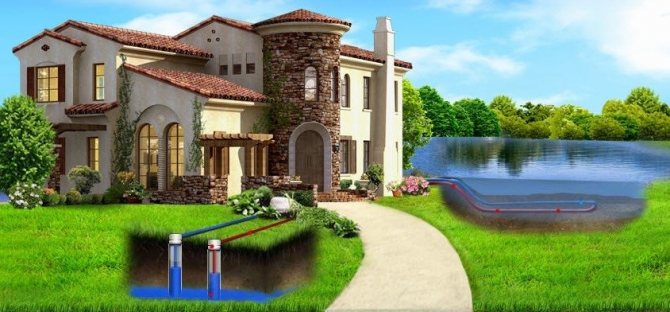

"Water-to-water" is installed where there is a body of water or groundwater nearby. In the first case, the reservoir is laid on the bottom of the reservoir, in the second, a well is drilled or several, if the area of the site allows.Sometimes the depth of groundwater is too deep, so the cost of installing such a heat pump can be very high.
Each type of heat pump has its own advantages and disadvantages, if the building is far from the reservoir or the groundwater is too deep, then water-to-water will not work. "Air-water" will be relevant only in relatively warm regions, where the air temperature in the cold season does not fall below -25 ° C.
DIY heat pump installation
Now that the main part of the system is ready, it remains to connect it to the devices for the intake and distribution of heat. This work can be done by yourself. This is not difficult. The process of installing a heat intake device can be different and largely depends on the type of pump that will be used as part of the heating system.
Vertical pump type ground water
Here, too, certain costs will be required, since when installing such a pump, you simply cannot do without using a drilling rig. All work begins with the creation of a well, the depth of which should be 50-150 meters... Next, the geothermal probe is lowered, after which it is connected to the pump.
Horizontal pump type soil water
When such a pump is installed, it is necessary to use a manifold formed by a pipe system. It should be located below the level of soil freezing. Accuracy and depth of collector placement largely depend on the climatic zone. First, the soil layer is removed. Then the pipes are laid, and then they are backfilled with earth.
You can use another way - laying of individual pipes for water in a pre-dug trench. Having decided to use it, you first need to dig trenches, in which the depth should be below the freezing level.
Method for calculating the power of a heat pump
In addition to determining the optimal energy source, it will be necessary to calculate the heat pump power required for heating. It depends on the amount of heat loss in the building. Let's calculate the power of a heat pump for heating a house using a specific example.
For this, we use the formula Q = k * V * ∆T, where
- Q is heat loss (kcal / hour). 1 kWh = 860 kcal / h;
- V is the volume of the house in m3 (the area is multiplied by the height of the ceilings);
- ∆Т is the ratio of the minimum temperatures outside and inside the premises during the coldest period of the year, ° С. Subtract the outside from the inner tº;
- k is the generalized heat transfer coefficient of the building. For a brick building with masonry in two layers k = 1; for a well-insulated building k = 0.6.
Thus, the calculation of the power of the heat pump for heating a brick house of 100 square meters and a ceiling height of 2.5 m, with a ttº difference from -30º outside to + 20º inside, will be as follows:
Q = (100x2.5) x (20- (-30)) x 1 = 12500 kcal / hour
12500/860 = 14.53 kW. That is, for a standard brick house with an area of 100 m, a 14-kilowatt device is needed.
The consumer accepts the choice of the type and power of the heat pump based on a number of conditions:
- geographical features of the area (proximity to water bodies, the presence of groundwater, a free area for a collector);
- features of the climate (temperature);
- type and internal volume of the room;
- financial opportunities.
Considering all the above aspects, you will be able to make the best choice of equipment. For a more efficient and correct selection of a heat pump, it is better to contact specialists, they will be able to make more detailed calculations and provide the economic feasibility of installing the equipment.
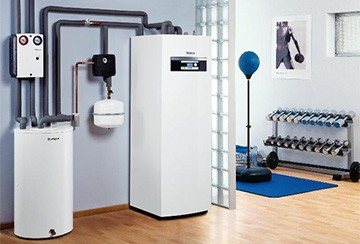

For a long time and very successfully, heat pumps have been used in domestic and industrial refrigerators and air conditioners.
Today, these devices have begun to be used to perform a function of the opposite nature - heating a dwelling during cold weather.
Let's take a look at how heat pumps are used to heat private houses and what you need to know in order to correctly calculate all of its components.
What is a heat pump, its scope
The technical definition of a heat pump is a device for transferring energy from one area to another while increasing the efficiency of its work. This mechanic is not difficult to illustrate. Let's imagine a bucket of cold water and a glass of hot water. The same amount of energy is expended to heat them from a certain heat mark. However, the effectiveness of its application is different. If at the same time reduce the temperature of the bucket of water by 1 degree, the obtained thermal energy can bring the liquid in the glass to almost a boil.
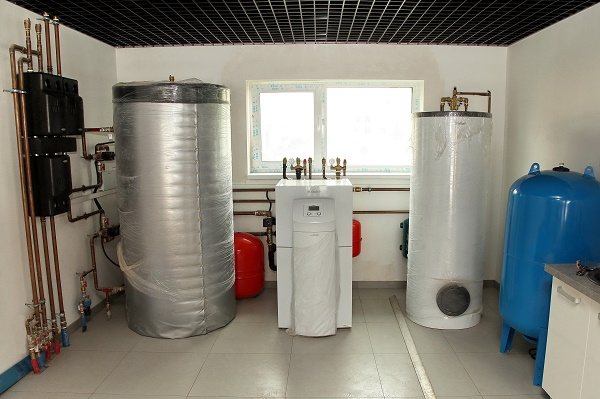

It is according to this mechanics that the heat pump works, with which you can heat the pool or completely provide heating for a country house. The installation transfers heat from one area to another, generally from outside the room to the inside. There are many applications for this technique.
- With a certain power rating of a heat pump, heating a house becomes inexpensive and efficient.
- It is easy to make DHW with a heat pump using re-heating boilers.
- With some effort and proper design, it is possible to create a completely autonomous heating system powered by solar panels.
- Most heat pump models are an acceptable option for underfloor heating used as a heating circuit.
To choose and purchase a suitable system, you must, first of all, correctly set the task facing it. And only after that, put forward the requirements for power and evaluate the acceptability of individual types of heat boilers to meet all needs.
Heat pump calculation example
We will select a heat pump for the heating system of a one-story house with a total area of 70 sq. m with a standard ceiling height (2.5 m), rational architecture and thermal insulation of the enclosing structures that meet the requirements of modern building codes. For heating the 1st quarter. m of such an object, according to generally accepted standards, it is necessary to spend 100 W of heat. Thus, to heat the whole house you will need:
Q = 70 x 100 = 7000 W = 7 kW of thermal energy.
We choose a heat pump of the "TeploDarom" brand (model L-024-WLC) with a thermal power of W = 7.7 kW. The compressor of the unit consumes N = 2.5 kW of electricity.
Reservoir calculation
The soil on the site allocated for the construction of the collector is clayey, the groundwater level is high (we take the calorific value p = 35 W / m).
The collector power is determined by the formula:
Qk = W - N = 7.7 - 2.5 = 5.2 kW.
L = 5200/35 = 148.5 m (approx).
Based on the fact that it is irrational to lay a circuit with a length of more than 100 m due to an excessively high hydraulic resistance, we accept the following: the heat pump manifold will consist of two circuits - 100 m and 50 m long.
The area of the site that will need to be allocated for the collector is determined by the formula:
S = L x A,
Where A is the step between adjacent sections of the contour. We accept: A = 0.8 m.
Then S = 150 x 0.8 = 120 sq. m.
Efficiency and COP
It clearly shows that ¾ of the energy we get from free sources. (Click to enlarge)
First, let's define in terms:
- Efficiency - coefficient of efficiency, i.e. how much useful energy is obtained as a percentage of the energy spent on the operation of the system;
- COP - coefficient of performance.
An indicator such as efficiency is often used for advertising purposes: "The efficiency of our pump is 500%!" It seems like they say the truth - for 1 kW of consumed energy (for the full operation of all systems and units), they produced 5 kW of thermal energy.
However, remember that the efficiency does not exceed 100% (this indicator is calculated for closed systems), so it would be more logical to use the COP indicator (used for calculating open systems), which shows the conversion factor of used energy into useful energy.
Usually COP is measured in numbers from 1 to 7. The higher the number, the more efficient the heat pump. In the example above (at 500% efficiency), the COP is 5.
Heat pump payback
When it comes to how long it takes a person to return his money invested in something, it means how profitable the investment itself was. In the field of heating, everything is quite difficult, since we provide ourselves with comfort and heat, and all systems are expensive, but in this case, you can look for such an option that would return the money spent by reducing costs during use. And when you start looking for a suitable solution, you compare everything: a gas boiler, a heat pump or an electric boiler. We will analyze which system will pay off faster and more efficiently.
The concept of payback, in this case, the introduction of a heat pump to modernize the existing heat supply system, to put it simply, can be explained as follows:
There is one system - an individual gas boiler, which provides autonomous heating and hot water supply. There is a split-system air conditioner that provides one room with cold. Installed 3 split systems in different rooms.
And there is a more economical advanced technology - a heat pump that will heat / cool houses and heat water in the right quantities for a house or apartment. It is necessary to determine how much the total cost of equipment and initial costs have changed, and also to estimate how much the annual operating costs of the selected types of equipment have decreased. And to determine in how many years, with the resulting savings, more expensive equipment will pay off. Ideally, several proposed design solutions are compared and the most cost-effective one is selected.
We will carry out the calculation and vyyaski, what is the payback period of a heat pump in Ukraine
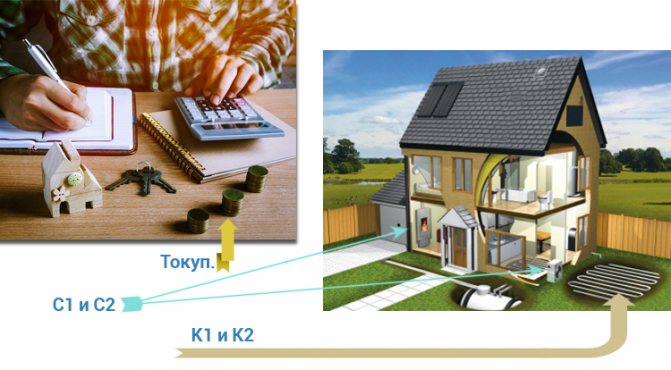

Let's consider a specific example
- The house is on 2 floors, well insulated, with a total area of 150 sq. M.
- Heat / heating distribution system: circuit 1 - underfloor heating, circuit 2 - radiators (or fan coil units).
- A gas boiler was installed for heating and hot water supply (DHW), for example 24kW, double-circuit.
- Air conditioning system from split systems for 3 rooms of the house.
Annual costs for heating and water heating
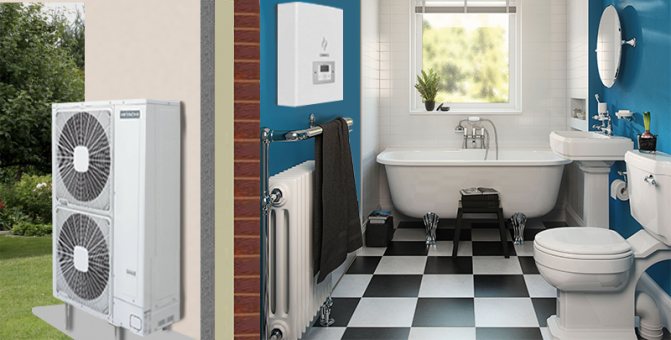

| Max. heating capacity of heat pump for heating, kW | 19993,59 |
| Max. power consumption of heat pump when operating for heating, kW | 7283,18 |
| Max. heating capacity of heat pump for hot water supply, kW | 2133,46 |
| Max. power consumption of the heat pump when operating on hot water supply, kW | 866,12 |
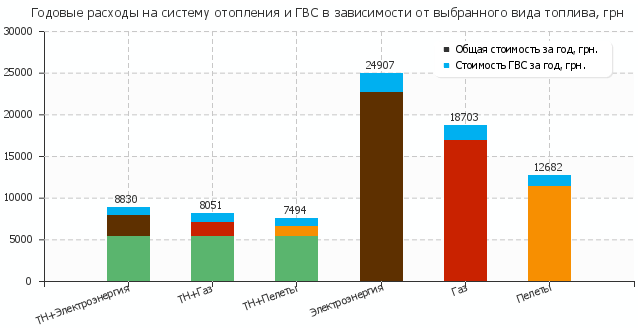

- The approximate cost of a boiler room with a 24 kW gas boiler (boiler, piping, wiring, tank, meter, installation) is about 1000 Euro. An air conditioning system (one split system) for such a house will cost about 800 euros. In total with the arrangement of the boiler house, design work, connection to the gas pipeline network and installation work - 6100 euros.
- The approximate cost of the Mycond heat pump with additional fan coil system, installation work and connection to the mains is 6,650 euros.
- Investment growth is: K2-K1 = 6650 - 6100 = 550 euros (or about 16500 UAH)
- Reducing operating costs is: C1-C2 = 27252 - 7644 = 19608 UAH.
- Payback period Tocup. = 16500/19608 = 0.84 years!
Ease of use of the heat pump
Heat pumps are the most versatile, multifunctional and energy efficient equipment for heating a home, apartment, office or commercial facility.
An intelligent control system with weekly or daily programming, automatic switching of seasonal settings, maintaining the temperature in the house, economy modes, controlling a slave boiler, boiler, circulation pumps, temperature control in two heating circuits, is the most advanced and advanced. Inverter control of the operation of the compressor, fan, pumps, allows maximum energy savings.
Benefits of heat pumps and the feasibility of their installation
As stated in the advertisement, the main advantage of heat pumps is the efficiency of heating. To some extent, this is how it works. If the heat pump has an energy extraction environment that provides optimal temperature, the installation works efficiently, heating costs are reduced by about 70-80%. However, there are always cases when a heat pump can be a waste of money.
The efficiency of a heat pump is determined by the following technological characteristics:
- the parameter of the boundary limit for reducing the temperature by the working fluid;
- the minimum difference in the temperatures of the external exchanger and the environment, at which the heat extraction is extremely small;
- the level of energy consumption and useful heat output.
The feasibility of using a heat pump depends on several factors.
- Areas where such equipment does not show good results are regions with frosty winters and low average daily temperatures. In this case, the heat pump is simply not able to take away enough heat from the environment, coming close to the zone of zero efficiency. First of all, this applies to air-to-air systems.
- With an increase in the volume of heated space, the technological parameters of the heat pump increase almost exponentially. Heat exchangers are becoming larger, the size and number of immersion probes in water or earth are increasing. At a certain point, the cost of a heat pump for heating, the necessary expenses for its installation and maintenance, as well as payment for the consumed power, become simply irrational investments. It is much cheaper to create a classic gas heating scheme with a boiler.
- The more complex the system, the more expensive and problematic it is to repair it in the event of a breakdown. This is a negative addition to the size of the heated area and the characteristics of the climatic zone.
Advice! In general, using a heat pump as the sole source of heat for a home can only be considered in a limited number of situations. It is always wise to use a comprehensive support system. Here, the number of possible combinations is limited only by the available energy sources and the financial capabilities of the owner.
The classic is a heat pump and a gas / solid fuel boiler working in conjunction. The idea is simple: the products of fuel combustion are discharged through a wide pipe. It houses the heat pump exchanger. Storage tanks and an indirect heating boiler are installed in the heating and hot water supply system. The equipment (boiler and pump) is activated simultaneously when the temperature of the liquid in the distribution network drops. Working in pairs, they almost completely utilize the energy of the burning fuel, showing efficiency indicators close to the maximum.
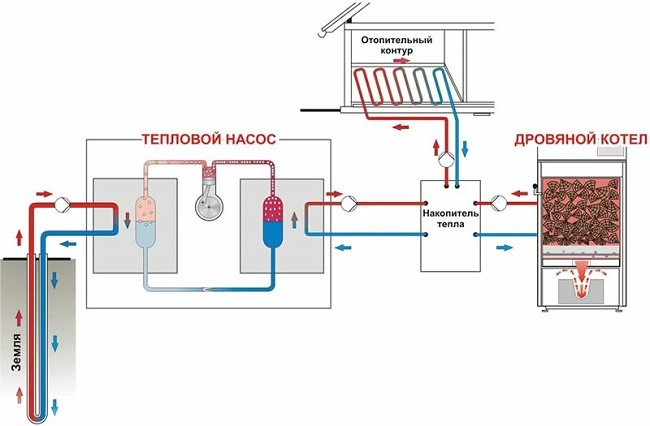

The system with adaptation to the characteristics of the environment is based on a thermal pump, a fan block, a heat gun of any class. At a sufficiently high air temperature outside (up to -5 ... -10 degrees Celsius), the heat pump operates normally, providing sufficient power output for heating. The design feature of the system is the location of its external heat exchanger in a separate ventilation duct. When the outdoor temperature drops below the optimal level, the supplied air is heated by a heat gun (diesel, electric or gas).
It is especially worth noting: most of the schemes that provide for adaptation to the air temperature or stabilizing the operating parameters of the heat pump are applied to air-to-air and air-to-water devices. Other systems, due to the external heat exchangers isolated in the ground or water, do not allow the creation of such "greenhouse" operating conditions.
Heat pump operation when working according to the ground-water scheme
The collector can be buried in three ways.
Horizontal option
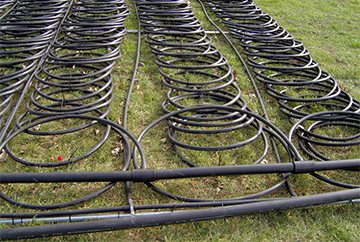

Pipes are laid in trenches like a snake to a depth exceeding the depth of soil freezing (on average - from 1 to 1.5 m).
Such a collector will require a plot of land of a sufficiently large area, but any homeowner can build it - no skills, other than the ability to work with a shovel, are needed.
However, it should be taken into account that the construction of a heat exchanger by hand is a rather laborious process.
Vertical option
The reservoir pipes in the form of loops having the shape of the letter “U” are immersed in wells with a depth of 20 to 100 m. If necessary, several such wells can be built. After installing the pipes, the wells are filled with cement mortar.
The advantage of a vertical collector is that a very small area is needed for its construction. However, there is no way to drill wells more than 20 m deep on your own - you will have to hire a team of drillers.
Combined option
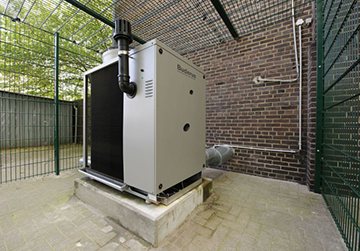

This collector can be considered a kind of horizontal, but much less space is required for its construction.
A round well is dug on the site with a depth of 2 m.
The heat exchanger tubes are laid in a spiral, so that the circuit is like a vertically installed spring.
Upon completion of the installation work, the well is filled up. As in the case of a horizontal heat exchanger, all the necessary amount of work can be done by hand.
The collector is filled with antifreeze - antifreeze or ethylene glycol solution. To ensure its circulation, a special pump is cut into the circuit. Having absorbed the heat of the soil, the antifreeze goes to the evaporator, where heat exchange takes place between it and the refrigerant.
It should be borne in mind that unlimited heat extraction from the soil, especially when the collector is located vertically, can lead to undesirable consequences for the geology and ecology of the site. Therefore, in the summer period, it is highly desirable to operate the heat pump of the "soil - water" type in a reverse mode - air conditioning.
The gas heating system has many advantages, and one of the main ones is the low cost of gas. How to equip home heating with gas, you will be prompted by the heating scheme of a private house with a gas boiler. Consider the heating system design and replacement requirements.
Read about the features of choosing solar panels for home heating in this topic.
How to calculate and choose a heat pump
Calculation and design of heat pumps
How to calculate and select a heat pump.
As you know, heat pumps use free, renewable energy sources: low-grade heat of air, soil, underground, open non-freezing water bodies, waste and waste water and air, as well as waste heat from technological enterprises. In order to collect it, electricity is expended, but the ratio of the amount of heat energy received to the amount of electricity consumed is about 3–7 times.
If we talk only about the sources of low-grade heat around us for heating purposes, it is; outdoor air with a temperature of –3 to +15 ° С, air removed from the room (15–25 ° С), subsoil (4–10 ° С) and ground (about 10 ° C) waters, lake and river water (5–10 ° С), ground surface (below the freezing point) (3–9 ° С) and deep ground (more than 6 m - 8 ° C).
Extraction of heat from the environment (inner district).
A liquid refrigerant medium is pumped in the evaporator at low pressure. The thermal level of temperatures surrounding the evaporator is higher than the corresponding boiling point of the working medium (the refrigerant is selected such that it can boil even at sub-zero temperatures). Due to this temperature difference, heat is transferred to the environment, to the working environment, which at these temperatures boils and evaporates (turns into steam). The heat required for this is taken from any of the above-listed low-grade heat sources.
Learn more about renewable energy sources
If atmospheric or ventilation air is selected as a heat source, heat pumps operating according to the "air-water" scheme are used. The pump can be located indoors or outdoors, with built-in or remote condenser. Air is blown through the heat exchanger (evaporator) using a fan.
As a source of low-grade thermal energy, groundwater with a relatively low temperature or the soil of the surface layers of the earth can be used. The heat content of the soil mass is generally higher. The thermal regime of the soil of the surface layers of the earth is formed under the influence of two main factors - the solar radiation falling on the surface and the flux of radiogenic heat from the earth's interior. Seasonal and daily changes in the intensity of solar radiation and the temperature of the outside air cause fluctuations in the temperature of the upper layers of the soil. The penetration depth of daily fluctuations in the outside air temperature and the intensity of the incident solar radiation, depending on specific soil and climatic conditions, ranges from several tens of centimeters to one and a half meters. The penetration depth of seasonal fluctuations in the outside air temperature and the intensity of the incident solar radiation does not exceed, as a rule, 15–20 m.
Types of horizontal heat exchangers:
- a heat exchanger made of pipes connected in series; - heat exchanger made of parallel-connected pipes; - horizontal collector laid in a trench; - a heat exchanger in the form of a loop; - a heat exchanger in the form of a spiral, located horizontally (the so-called "slinky" collector); - a heat exchanger in the form of a spiral, located vertically.
Water accumulates solar heat well. Even in the cold winter period, groundwater has a constant temperature from +7 to + 12 ° C. This is the advantage of this heat source. Due to the constant temperature level, this heat source has a high conversion rate through the heat pump all year round. Unfortunately, there is not enough groundwater everywhere. When used as a source of groundwater, the supply is carried out from the well with the help of a submersible pump to the inlet to the heat exchanger (evaporator) of the heat pump operating according to the “water-to-water / open system” scheme, from the outlet of the heat exchanger, water is either pumped into another well, or discharged into a body of water. The advantage of open systems is the ability to obtain a large amount of thermal energy at relatively low costs. However, the wells require maintenance. In addition, the use of such systems is not possible in all areas. The main requirements for soil and groundwater are as follows:
- sufficient water permeability of the soil, allowing replenishment of water supplies; - good chemical composition of groundwater (eg low iron content) to avoid problems associated with the formation of deposits on the pipe walls and corrosion.
Open systems are more often used for heating or cooling large buildings. The world's largest geothermal heat transfer system uses groundwater as a source of low-grade thermal energy. This system is located in Louisville, Kentucky, USA. The system is used for heat and cold supply of the hotel and office complex; its capacity is approximately 10 MW.
Let's take another source - a reservoir, on its bottom you can lay loops from a plastic pipe, the scheme "water-water / closed system". An ethylene glycol solution (antifreeze) circulates through the pipeline, which transfers heat to the refrigerant through the heat exchanger (evaporator) of the heat pump.
The soil has the ability to accumulate solar energy over a long period of time, which ensures a relatively uniform temperature of the heat source throughout the year and, thus, a high conversion factor of the heat pump.The temperature in the topsoil varies with the season. Below the freezing point, these temperature fluctuations are significantly reduced. The heat accumulated in the ground is recovered by means of horizontally laid sealed heat exchangers, also called ground collectors, or by means of vertically laid heat exchangers, so-called geothermal probes. The heat of the environment is transferred by a mixture of water and ethylene glycol (brine or medium), the freezing point of which should be approximately -13 ° C (take the manufacturer's data into account). Thanks to this, the brine does not freeze during operation.
This means that there are two options for obtaining low-potential heat from the soil. Horizontal laying of plastic pipes in trenches 1.3–1.7 m deep, depending on the climatic conditions of the area, or vertical wells 20–100 m deep. Pipes can be laid in trenches in the form of spirals, but with a laying depth of 2– 4 m, this will significantly reduce the overall length of the trenches. The maximum heat transfer of the surface soil is from 7 to 25 W with the metering point, from the geothermal 20-50 W with the metering point. According to manufacturing companies, the service life of trenches and wells is over 100 years.
A little more about vertical ground heat exchangers.
Since 1986, in Switzerland, near Zurich, studies have been carried out on a system with vertical ground heat exchangers [4]. A vertical ground heat exchanger of a coaxial type with a depth of 105 m was arranged in the soil massif. This heat exchanger was used as a source of low-grade thermal energy for a heat transfer system installed in a single-family residential building. The vertical ground heat exchanger provided a peak power of approximately 70 watts per meter of length, which created a significant thermal load on the surrounding soil mass. The annual heat production is about 13 MWh.
At a distance of 0.5 and 1 m from the main well, two additional wells were drilled, in which temperature sensors were installed at a depth of 1, 2, 5, 10, 20, 35, 50, 65, 85 and 105 m, after which the wells were filled clay-cement mixture. The temperature was measured every thirty minutes. In addition to the soil temperature, other parameters were also recorded: the speed of movement of the coolant, the energy consumption of the compressor drive, the air temperature, etc.
The first observation period lasted from 1986 to 1991. Measurements have shown that the influence of the heat of the outside air and solar radiation is observed in the surface layer of the soil at a depth of 15 m. Below this level, the thermal regime of the soil is formed mainly due to the heat of the earth's interior. During the first 2-3 years of operation, the temperature of the soil mass surrounding the vertical heat exchanger dropped sharply, but every year the temperature decrease decreased, and after a few years the system entered a mode close to constant, when the temperature of the soil mass around the heat exchanger became 1 -2 ° C.
In the fall of 1996, ten years after the start of operation of the system, measurements were resumed. These measurements showed that the soil temperature did not change significantly. In subsequent years, slight fluctuations in ground temperature were recorded in the range of 0.5 ° C, depending on the annual heating load. Thus, the system reached a quasi-stationary regime after the first few years of operation.
Based on the experimental data, mathematical models of the processes taking place in the soil massif were built, which made it possible to make a long-term forecast of changes in the temperature of the soil massif.
Mathematical modeling showed that the annual decrease in temperature will gradually decrease, and the volume of the soil mass around the heat exchanger, subject to a decrease in temperature, will increase every year.At the end of the operating period, the regeneration process begins: the soil temperature begins to rise. The nature of the process of regeneration is similar to the nature of the process of "extraction" of heat: in the first years of operation, there is a sharp increase in soil temperature, and in subsequent years the rate of temperature rise decreases. The length of the "regeneration" period depends on the length of the operating period. These two periods are approximately the same. In this case, the period of operation of the ground heat exchanger was thirty years, and the period of "regeneration" is also estimated at thirty years.
Thus, heating and cooling systems for buildings that use low-grade heat from the earth represent a reliable source of energy that can be used everywhere. This source can be used for a sufficiently long time and can be renewed at the end of the operating period.
Calculation of the horizontal heat pump header
The removal of heat from each meter of the pipe depends on many parameters: the depth of installation, the availability of groundwater, the quality of the soil, etc. Roughly it can be considered that for horizontal collectors it is 20 W.m.p. More precisely: dry sand - 10, dry clay - 20, wet clay - 25, clay with a high water content - 35 W.m.p. The difference in the temperature of the coolant in the direct and return lines of the loop in the calculations is usually taken as 3 ° C. On the collector site, buildings should not be erected so that the heat of the earth, i.e. our energy source was replenished with energy from solar radiation.
The minimum distance between the laid pipes should be at least 0.7–0.8 m. The length of one trench can vary from 30 to 150 m. It is important that the lengths of the connected circuits are approximately the same. It is recommended to use an ethylene glycol solution (medium) with a freezing point of approximately -13 ° C as the heating medium in the primary circuit. In the calculations, it should be taken into account that the heat capacity of the solution at a temperature of 0 ° C is 3.7 kJ / (kg K), and the density is 1.05 g / cm3. When using a medium, the pressure loss in the pipes is 1.5 times greater than when circulating water. To calculate the parameters of the primary circuit of the heat pump installation, it will be necessary to determine the flow rate of the medium:
Vs = Qo 3600 / (1.05 3.7 .t),
Where .t - the temperature difference between the supply and return lines, which is often assumed to be 3 oK. Then Qo - thermal power received from a low-potential source (ground). The latter value is calculated as the difference between the total power of the heat pump Qwp and the electrical power spent on heating the refrigerant. P:
Qo = Qwp - P, kW.
Total length of collector pipes L and the total area of the site for it A calculated by the formulas:
L = Qo / q,
A = L da.
Here q - specific (from 1 m of pipe) heat removal; da - distance between pipes (laying step).
Calculation example. Heat Pump.
Initial conditions: heat demand of a cottage with an area of 120–240 m2 (based on heat losses, taking into account infiltration) - 13 kW; the water temperature in the heating system is taken to be 35 ° C (underfloor heating); the minimum temperature of the coolant at the outlet to the evaporator is 0 ° С. To heat the building, a 14.5 kW heat pump was selected from the existing technical range of equipment, taking into account the losses on the viscosity of the medium, when extracting and transferring heat energy from the ground, is 3.22 kW. Heat removal from the surface layer of the soil (dry clay), q equals 20 W / m.p. In accordance with the formulas, we calculate:
1) required heat output of the collector Qo = 14.5 - 3.22 = 11.28 kW;
2) total pipe length L = Qo / q = 11.28 / 0.020 = 564 l.p. To organize such a collector, you will need 6 circuits 100 m long;
3) with a laying step of 0.75 m, the required area of the site A = 600 x 0.75 = 450 m2;
4) general charge of ethylene glycol solution Vs = 11.28 3600 / (1.05 3.7 3) = 3.51 m3, in one circuit is equal to 0.58 m3.
For the collector device, we choose a plastic pipe of standard size 32x3. The pressure loss in it will be 45 Pa / m.p .; the resistance of one circuit is approximately 7 kPa; coolant flow rate - 0.3 m / s.
Probe calculation
When using vertical wells with a depth of 20 to 100 m, U-shaped plastic pipes (with diameters from 32 mm) are immersed in them. As a rule, two loops are inserted into one well, filled with a suspension solution. On average, the specific heat output of such a probe can be taken equal to 50 W / m.p. You can also focus on the following data on heat output:
- dry sedimentary rocks - 20 W / m; - stony soil and water-saturated sedimentary rocks - 50 W / m; - rocks with high thermal conductivity - 70 W / m; - groundwater - 80 W / m.
The soil temperature at a depth of more than 15 m is constant and is approximately +9 ° С. The distance between the wells should be more than 5 m. In the presence of underground currents, the wells should be located on a line perpendicular to the flow.
The selection of pipe diameters is carried out based on the pressure loss for the required coolant flow rate. The calculation of the liquid flow rate can be carried out for t = 5 ° С.
Calculation example.
The initial data are the same as in the above calculation of the horizontal reservoir. With a specific heat output of the probe of 50 W / m and a required power of 11.28 kW, the probe length L should be 225 m.
To set up a collector, it is necessary to drill three wells with a depth of 75 m. In each of them we place two loops of a 32x3 pipe; in total - 6 circuits, 150 m each.
The total flow rate of the coolant at .t = 5 ° С will be 2.1 m3 / h; flow rate through one circuit - 0.35 m3 / h. The circuits will have the following hydraulic characteristics: pressure loss in the pipe - 96 Pa / m (heat carrier - 25% ethylene glycol solution); loop resistance - 14.4 kPa; flow speed - 0.3 m / s.
Equipment selection
Since the temperature of the antifreeze can vary (from –5 to +20 ° C), a hydraulic expansion tank is required in the primary circuit of the heat pump unit.
It is also recommended to install a storage tank on the heating (condensing) line of the heat pump: the compressor of the heat pump operates in the on-off mode. Too frequent starts can lead to accelerated wear of its parts. The tank is also useful as an energy accumulator - in case of a power outage. Its minimum volume is taken at the rate of 20-30 liters per 1 kW of heat pump power.
When using bivalence, a second source of energy (electric, gas, liquid or solid fuel boiler), it is connected to the circuit through an accumulator tank, which is also a thermohydrodistributor, the activation of the boiler is controlled by a heat pump or the upper level of the automation system.
In the event of possible power outages, the power of the installed heat pump can be increased by a coefficient calculated by the formula: f = 24 / (24 - t off), where t off is the duration of the power outage.
In the event of a possible power outage for 4 hours, this coefficient will be equal to 1.2.
The power of the heat pump can be selected based on the monovalent or bivalent mode of its operation. In the first case, it is assumed that the heat pump is used as the only generator of heat energy.
It should be borne in mind: even in our country, the duration of periods with low air temperatures is a small part of the heating season. For example, for the Central region of Russia, the time when the temperature drops below –10 ° С is only 900 hours (38 days), while the duration of the season itself is 5112 hours, and the average January temperature is approximately –10 ° С. Therefore, the most expedient is the operation of the heat pump in a bivalent mode, providing for the inclusion of an additional source during periods when the air temperature drops below a certain one: –5 ° С - in the southern regions of Russia, –10 ° С - in the central ones. This makes it possible to reduce the cost of the heat pump and, especially, of the work on the installation of the primary circuit (laying trenches, drilling wells, etc.), which greatly increases with increasing capacity of the installation.
In the Central region of Russia, for a rough estimate when selecting a heat pump operating in bivalent mode, one can focus on the ratio 70/30: 70% of the heat demand is covered by the heat pump, and the remaining 30 - by electric or other source of heat energy. In the southern regions, the power ratio of the heat pump and the additional heat source, which is often used in Western Europe, can be guided: 50 to 50.
For a cottage with an area of 200 m2 for 4 people with a heat loss of 70 W / m2 (calculated for –28 ° C outside air temperature), the heat demand will be 14 kW. To this value, add 700 W for the preparation of domestic hot water. As a result, the required power of the heat pump will be 14.7 kW.
If there is a possibility of a temporary power outage, you need to increase this number by the appropriate factor. Let's say the daily shutdown time is 4 hours, then the heat pump power should be 17.6 kW (the multiplying factor is 1.2). In the case of a monovalent mode, you can choose a ground-to-water heat pump with a capacity of 17.1 kW, consuming 6.0 kW of electricity.
For a bivalent system with an additional electric heater and a cold water supply temperature of 10 ° C for the need to obtain hot water and a safety factor, the power of the heat pump must be 11.4 W, and the power of the electric boiler must be 6.2 kW (in total - 17.6) ... The peak electrical power consumed by the system will be 9.7 kW.
The approximate cost of electricity consumed per season, when the heat pump operates in monovalent mode, will be 500 rubles, and in bivalent mode at temperatures below (-10 ° C) - 12,500. The cost of the energy carrier when using only the appropriate boiler will be: electricity - 42,000, diesel fuel - 25,000, and gas - about 8,000 rubles. (in the presence of a supplied pipe and low gas prices in Russia). At present, for our conditions, in terms of efficiency of work, a heat pump can only be compared with a gas boiler of new series, and in terms of operating costs, durability, safety (no boiler room is required) and environmental friendliness, it surpasses all other types of heat energy production.
Note that when installing heat pumps, first of all, you should take care of building insulation and installing double-glazed windows with low thermal conductivity, which will reduce the heat loss of the building, and hence the cost of work and equipment.
https://www.patlah.ru
© "Encyclopedia of Technologies and Techniques" Patlakh V.V. 1993-2007
Calculation of the horizontal heat pump header
The efficiency of a horizontal collector depends on the temperature of the medium in which it is immersed, its thermal conductivity, and the area of contact with the pipe surface. The calculation method is rather complicated, therefore, in most cases, averaged data are used.
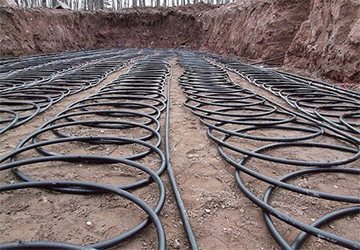

It is believed that each meter of the heat exchanger provides the HP with the following heat output:
- 10 W - when buried in dry sandy or rocky soil;
- 20 W - in dry clay soil;
- 25 W - in wet clay soil;
- 35 W - in very damp clay soil.
Thus, to calculate the length of the collector (L), the required thermal power (Q) should be divided by the calorific value of the soil (p):
L = Q / p.
The values given can only be considered valid if the following conditions are met:
- The plot of land above the collector is not built-up, not shaded or planted with trees or bushes.
- The distance between adjacent turns of the spiral or sections of the "snake" is at least 0.7 m.
How heat pumps work
Any heat pump has a working medium called a refrigerant. Usually freon acts in this capacity, less often ammonia. The device itself consists of only three components:
The evaporator and the condenser are two tanks that look like long curved tubes - coils.The condenser is connected at one end to the compressor outlet, and the evaporator to the inlet. The ends of the coils are joined and a pressure reducing valve is installed at the junction between them. The evaporator is in contact - directly or indirectly - with the source medium, and the condenser is in contact with the heating or DHW system.
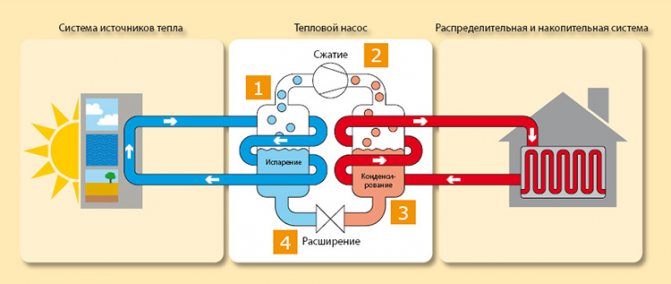

How the heat pump works
HP operation is based on the interdependence of gas volume, pressure and temperature. Here's what happens inside the unit:
- Ammonia, freon or other refrigerant, moving along the evaporator, heats up from the source medium, for example, to a temperature of +5 degrees.
- After passing through the evaporator, the gas reaches the compressor, which pumps it to the condenser.
- The refrigerant discharged by the compressor is held in the condenser by a pressure reducing valve, so its pressure is higher here than in the evaporator. As you know, with increasing pressure, the temperature of any gas increases. This is exactly what happens with the refrigerant - it heats up to 60 - 70 degrees. Since the condenser is washed by the coolant circulating in the heating system, the latter also heats up.
- The refrigerant is discharged in small portions through the pressure reducing valve to the evaporator, where its pressure drops again. The gas expands and cools down, and since part of the internal energy was lost by it as a result of heat exchange at the previous stage, its temperature drops below the initial +5 degrees. Following the evaporator, it heats up again, then it is pumped into the condenser by the compressor - and so on in a circle. Scientifically, this process is called the Carnot cycle.
But the heat pump still remains very profitable: for each spent kW * h of electricity, it is possible to obtain from 3 to 5 kW * h of heat.
Energy saving
The use of alternative energy sources today is a priority task for almost all spheres of modern human activity. The active use of wind, water, sun energy allows not only to significantly reduce the cost of financial resources in the implementation of all kinds of technological operations, but also has a beneficial effect on the state of the environment (associated with a decrease in emissions of pollutants into the atmosphere).
A similar trend can be seen in the residential sector, in view of which solar collectors, wind generators, economical heat generators are increasingly used to create favorable living conditions, as well as measures are being taken to increase the level of thermal insulation of all elements of the structure.
A very effective measure from an economic point of view is the use of heat pumps - geothermal energy sources. In principle, heat pumps are designed in such a way that they can extract heat literally bit by bit from the environment, and only then transform it and direct it to the place of direct use. Air, water, soil can act as energy sources for a heat pump, while the whole process is realized due to the physical properties of some substances (refrigerants) to boil at low temperatures.
Thus, the costs of traditional resources for the performance of the presented heat generator are associated only with the transportation of energy, while its main part is involved from outside. Due to the fundamental characteristics of heat pumps, the coefficient of their performance can reach 3-5 units, that is, spending 100 W of electrical energy for the operation of the heat pump, you can get up to 0.5 kW of thermal power.
